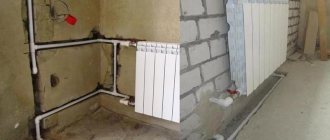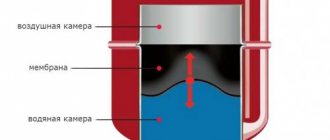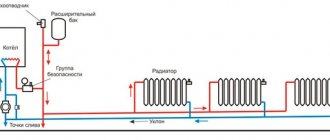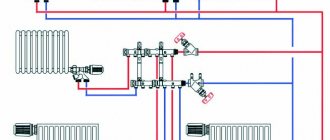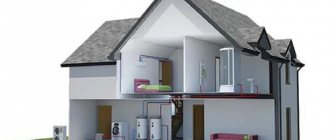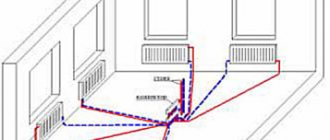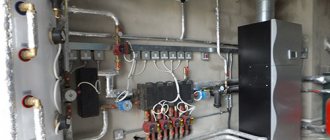Which heating system to choose
A fireplace or stove can handle heating a small country house, but for a cottage such a solution is unacceptable. It's nice to spend an evening by the fireplace, but lighting wood in all rooms every day is tiring and irrational. The power source for the heating system in a private home should be the most affordable type of fuel, especially if you are planning to do it yourself:
- Electricity.
- Coal.
- Briquettes of peat and shavings.
- Firewood.
- Liquid fuel (diesel fuel, fuel oil, diesel fuel).
- Gas.
Collector system
One of the subtypes of a two-pipe system is called a manifold distribution. It must contain a separate circuit for each device. The collector is used for the central entrance, after which a branching occurs for the heating system in each apartment.
The types of heating system wiring under consideration exhibit positive and negative qualities during operation, including:
- The temperature will be distributed evenly throughout the rooms.
- It is also used for large apartments.
- Each circuit can be adjusted independently and separately.
- Hidden installation process.
- There are no pressure differences in different areas.
- A small number of connections, which increases the reliability of the system.
- The contours will remain unchanged even if new nodes are added to the system.
- During installation, which is not always possible for a beginner, it is necessary to arrange a significant number of grooves.
- The whole system will incur large costs.
- There is no possibility to arrange a natural flow of water.
Water heating
This is the most common system in which water or other non-freezing liquid circulates through pipes. The type of boiler depends on what fuel you have. The system consists of a boiler and a closed loop of pipes connected to the premises. Heating of the rooms is provided by radiators, the cooled water flows back into the boiler.
pros
- Coolant availability.
- Constant volume of water in the system.
- Easy to install.
- Uniform heating of all rooms along the circuit.
Minuses
- Caring for radiators, the heat transfer of which decreases when dirty.
- Slow heating of rooms.
- Possibility of pipe leakage due to corrosion.
- Requirements for the purity of water in the system.
- The system must constantly work in cold weather, otherwise the water may freeze and the pipes will burst.
Scheme
The do-it-yourself water heating scheme for a private house looks like this:
Water heating with a gas boiler is a proven traditional system. Most private houses are heated in this way. For a house in which you live permanently, this system is suitable, but for heating a summer house it is too expensive.
The principle of operation of a two-pipe heating system
Which heating system is more efficient, one-pipe or two-pipe? We have already considered the first one. Let's look at the second one.
Such a system a priori implies the presence of two pipelines located around the perimeter of the heated room. Radiators are inserted between them, which dampen pressure drops and create hydraulic bridges. However, the problems created by this can be leveled out due to the correct configuration of the CO.
- Two-pipe systems can be vertical and horizontal, depending on the location of the supply and return (parallel to the ceilings or perpendicular to them).
However, it should be understood that the circuit installed in apartment buildings is essentially a horizontal two-pipe CO system. A two-pipe vertical one will be obtained in the case when the radiators are installed not in the gaps of the risers (as in the case described above), but between the supply and return. - Associated and dead-end COs.
The first type includes systems in which hot water, passing through the radiator, moves in the same direction along the return line. If after the heating device the direction of movement of the coolant changes, the system is classified as a dead end. The required option is selected taking into account the presence of doorways on the CO pipe laying line, which are quite difficult to bypass; it is easier to return the water in the direction in which it came. - With bottom and top filling.
- With natural (EC) and forced (PC) circulation.
Air heating
The house is heated with hot air, which can be heated by steam, hot water, heat from combustion of fuel, or electricity. In the system, warm air from the air heater enters the premises through an air duct.
Heaters for air heating are presented on the Russian market:
- Fan coil units operating using hot water. Almost all of the presented installations of American, European or Asian production are intended for office buildings, although you can also find units for private homes.
- Gas air heaters.
- Heaters running on diesel or solid fuel.
- Airhandler electric heaters are installed in air conditioners with a fan. Typically electric heaters work with a heat pump.
pros
- Problems with the coolant are excluded, that is, the system cannot leak or freeze.
- Possible associated humidification of indoor air.
- Air conditioning and ventilation in the house.
- The efficiency reaches 90%.
- Rapid heating of the air.
Minuses
- High price.
- A fairly large area is required to install the generator.
- Relatively low heat transfer.
Private houses are heated with air only in 30% of cases, which is mainly explained by the high cost of installation and maintenance. For a country house, do-it-yourself air heating can be very convenient, provided there is an uninterrupted power supply.
Induction system
Modern and economical equipment operating on the principle of electromagnetic induction. When an electric current passes, a coil of wire forms a strong electromagnetic field and heats the ferromagnet. In the case of a heater, the coil is wound on a pipe made of a special material with a steel core. The device is connected to a system filled with coolant (water, oil, ethylene glycol), which rises when heated and starts the circuit.
In industry, steel has been melted using this method for two hundred years, that is, the principle has been known for a long time and the technology cannot be called new.
pros
- Durability. The warranty on induction heaters is 10 years or more. The absence of moving elements in the system eliminates mechanical wear.
- Scale does not form in the heating system of a private house, so an induction boiler is equally effective in the first and tenth year of operation.
- Completely silent operation. There are no pumps in the system, so the electric boiler does not make noise.
- To install an induction heater, no additional space is required, and installation can be done with your own hands.
- Rapid heating of the coolant due to the lack of insulation - the rod heats the coolant.
Minuses
- High price. Factory models are made using modern materials, and this explains the high cost. You can build an induction boiler yourself, but in terms of efficiency it will be inferior to factory samples.
- A boiler with a power of over 7 kW requires an electrical network of 380 V.
- If the water supply to the system stops, the equipment will overheat and fail. To avoid breakdowns, the system must be equipped with a pressure sensor and an automatic device shutdown.
Two-pipe system
Two-pipe heating system. Click on photo to enlarge.
Two-pipe wiring of heating systems involves the presence of two pipes: one is supplied with hot coolant to the heating elements, and the other is cooled back into the boiler. The batteries are located in parallel, which makes it possible to regulate the heat transfer of each element separately, without affecting the functioning of others.
Within the framework of a two-pipe scheme, the following types of wiring of central water heating systems are distinguished: mains with spaced risers and mains with nearby risers.
The first type of wiring is a larger diameter pipe (supply) in the attic, and from there risers of smaller diameter are laid to each of the radiators in the system. The cooled coolant is discharged through a common “return” riser, which is mounted under the radiators, that is, at floor level. The general supply riser located in the attic must be carefully insulated to ensure maximum efficiency of the heating system.
When distributing with spaced pipes, if a pump is not used, it is important to observe the slopes: the supply should be mounted at a slight (up to 10 cm per 20 linear meters) slope from the boiler, and the “return”, on the contrary, at a slope towards the boiler.
Wiring with nearby pipes involves installing direct and return risers under the batteries. The hot coolant will rise up and warm up the radiator, and the cooled coolant will fall down and flow into the return pipe.
There are also mixed wiring schemes, for example, the coolant is supplied to the heating elements sequentially, and the cooled water is discharged into a common return riser. Another case is collector wiring, that is, the presence of its own circuit, powered by a common supply, on each floor of a multi-story building.
In general, the choice of heating system wiring method is determined by many factors, among which the most important are the power of the boiler, the number of radiators and the number of sections in each of them, the number of floors of the building, etc.
The issue with the number of pipes in the heating system has been resolved. Let's move on to an overview of the main methods of connecting radiators to supply and return risers.
Lateral one-way connection
Such an organization of heating systems involves connecting the supply and “return” to the heating element on one side: the direct riser is connected from above, and the return riser is connected from below. This is the recommended order, otherwise heat loss may increase by 7%, since the battery sections will heat up unevenly. The lateral one-sided design is suitable for radiators with more than 15 sections, as well as for multi-storey buildings with parallel connection of heating elements.
Diagonal connection
This method is recommended for heating systems with long radiators. The difference with a lateral one-way connection is that the risers are connected to the battery from different sides, for example, the direct riser is connected to the leftmost section at the top, and the reverse riser is connected to the rightmost section at the bottom.
Only in this way is maximum heat transfer achieved, and heat loss is reduced to 2%. If you install pipes in the reverse order (supply from below, return from above), the efficiency of heating the room will decrease by 10%.
Bottom connection
This layout outperforms others because of its aesthetic appeal: only the radiator is visible, and all the pipes are hidden under it or even “hidden” under the floor. However, heat loss in this case can increase up to 15%, since the battery sections will heat up unevenly.
Tichelman connection
Tichelman connection. Click on photo to enlarge.
This type of wiring is used when organizing heating systems in large buildings: hangars, warehouses, high-rise buildings, etc. This scheme contains a standard set of elements. The difference is that when installing risers in different sections of the highway, pipes of different diameters are used. These are called constriction devices.
For example, if the straight riser coming from the boiler has a diameter of 50 mm, then after a 20 mm outlet to the first heating element, the supply diameter is reduced to 40 mm. A 32 mm riser is installed after the second radiator, and a 25 mm riser is installed after the third. This arrangement of hot coolant supply allows energy to be distributed approximately equally between all batteries.
The return riser is assembled in a mirror way: a pipe of the smallest diameter goes from the first radiator, and a 50-mm pipe goes from the last one to the boiler.
Geothermal system
A non-standard approach to solving the problem of heating a country house. New technologies make it possible to use the energy potential of the earth by installing a geothermal heating system at home with your own hands. Up to 98 percent of solar energy is accumulated in the ground; heat is retained deep in the ground even in winter.
Special equipment helps deliver energy to homes for heating.
Geothermal heating in a simplified diagram looks like a heat pump and heat exchanger operating on the principle of an air conditioner. The heat pump is included in the internal and external circuits. Internal - a heating system made from ordinary pipes and radiators in the house. The external circuit (heat exchanger) is located underground. Coolants - water or liquid with antifreeze. The pump can operate in heater or air conditioner mode.
pros
- A geothermal heater can be installed in any location.
- The system does not pose a danger to humans and the environment
- You can receive an unlimited amount of heat.
- Minimum operating costs.
- You get geothermal heat for free, but you will have to pay for the operation of a pump running from the electrical network - a kilowatt of electricity provides 3-5 kW of heat.
Minuses
- High price of equipment and installation. The heating system will pay for itself in 7-8 years.
- Constructing a geothermal installation on your own is problematic, since the structure is located at a depth of about 100 meters and requires special equipment.
- Horizontal structures lie below the soil freezing level, but the collector occupies large areas. For example, to heat a house of 200 square meters. m. requires the use of heat from 500 sq. m of soil, not shaded by trees and other buildings.
Solar heating
An innovative technology that is becoming more and more popular in the world every day. If you are interested in this heating system, take the choice of equipment seriously, calculate the area, power, and find a suitable place for installation. A solar heating system will last more than 25 years, and with constant use will pay for itself in three years.
Solar panels in a country house are used to generate electricity. This type of heating is optimally used for electric heaters and heated floors.
pros
- No fuel costs.
- Environmental Safety.
- Easy to use and the ability to install solar heating for a private home with your own hands.
- Photocells and equipment are becoming affordable.
Minuses
- On cloudy days, little energy is produced.
- Expensive equipment and installation.
- The need for complex calculations and correct installation of elements.
- A number of installation conditions: roof at an angle of 30 degrees, absence of trees and buildings shading the roof, favorable climate.
Steam heating
The old heating method has not lost its relevance against the backdrop of innovative systems. The coolant is steam, installation of the heating system is simple. The source is a steam boiler from which heat enters the pipes and radiators of the reduction-cooling equipment or steam turbine. Cooling, the steam turns into condensate and returns back.
Theoretically, you can build steam heating with your own hands, but boilers are not installed in private homes. The boiler is very large, the steam temperature exceeds 100°C, operation requires a professional approach. Traditionally, enterprises that use steam in their production process are heated this way, and its excess is used for heating.
Reliability of operation and temperature significantly depend on the quality of the boiler in this system, so it should be selected taking into account the area and structural features. Steam boilers operate on various fuels: liquid, solid, combined, natural gas.
pros
- Relative cheapness of the boiler.
- Fast heating of the room.
- Preservation of heat in the system.
Minuses
- Cumbersomeness and danger of steam boilers if used incorrectly.
- Heating heating devices to high temperatures.
- Inability to smoothly regulate room temperature.
- Filling the system with steam is accompanied by noise.
- Complex installation of the system.
Electric heating
A well-known heating system using electrical appliances in which heat is generated by a current passing through a conductor. Often the electrical system is used as an auxiliary system, but in the absence of gas in the house it can also be the main one.
pros
- Ecological cleanliness.
- Easy installation.
- Heating appliances can be freely rearranged into any room with electrical wiring.
Minuses
- The need to pay for consumed electricity, the consumption of which will be large.
- When the power supply is turned off, the heating system does not work.
- When electrical appliances operate, oxygen is burned, so rooms need to be ventilated as often as possible.
In dachas and small houses, electric heating is often used, but heating a large house will require a lot of electricity. If you decide to choose this particular system as it is the simplest and does not require special knowledge for self-installation, take care of high-quality thermal insulation of the house.
One- and two-pipe connection
The supply and removal of coolant can be done using one or two pipes. Each of the methods has its positive and negative sides, as well as application features, taking into account the type of circuit used.
The presence of a second pipe has a slight effect on the appearance of the wiring due to the lower method of connection to the batteries and the ability to choose a smaller cross-section of the pipeline.
Single-pipe option
The heating option using one pipe for supplying coolant and discharging cooled water is called single-pipe. The main advantage of this layout is that it reduces the total length of the pipeline. The main advantages of this method:
- minimal risk of leaks;
- ease of installation;
- lower costs for the purchase of various plumbing fixtures.
How to connect a gas boiler, see this video:
The disadvantage of a single-pipe heating scheme is the gradual decrease in the temperature of the coolant passing sequentially through all the batteries. Therefore, it is necessary to install a larger area of radiator batteries located at the end of the circuit (more sections), which often offsets the savings from reducing the total length of the pipeline.
Also for this reason, there may be restrictions for the circuit on the number of connected batteries. If there are a lot of them, then the last devices will hardly heat up during the movement of the coolant.
The disadvantage of a single-pipe scheme is a gradual decrease in coolant temperature
In addition, a problem arises during the calculation of thermal efficiency. In this case, it must be taken into account that disconnecting the first batteries from the heating system will lead to an increase in the temperature of the incoming coolant for subsequent radiators.
Heating devices are most often connected via a bypass, so that it is possible to disconnect any battery without stopping the entire system. Although you don’t have to do this to save on valves, in this case you will have to stop the system if repair work is necessary.
The most economical option is to install one steel pipe with a cross-section of 3-4 cm without heating batteries. The absence of fittings and valves will make this system more practical due to the low risk of leaks.
Using two pipes
A circuit system where one pipe is installed to supply coolant to the batteries, and the other to discharge cooled water, is called a two-pipe system. The advantages of this scheme are as follows:
- the limitation on the number of installed batteries for the circuit will depend only on the throughput size of the pipeline;
- disconnecting one or a group of batteries will not affect the temperature of the coolant supply to the remaining radiators;
- the temperature of the coolant supplied to all radiators is the same.
The main disadvantage of this system is the increase in the total length of the pipeline. This leads to additional material costs, as well as complex decisions about the location of pipes in the design of the room.
The two-pipe heating circuit, taking into account the movement of water, is divided into dead-end and associated. In the latter case, both flows move in the same direction, that is, the length of the water circulation cycle for each battery is the same. Moreover, the heating speed is the same during system startup.
The disadvantage of a two-pipe system is the increase in the total length of the pipeline
With dead-end wiring, the direction of hot coolant and cold water is opposite. Heating of the batteries closest to the boiler equipment occurs faster. The lower the coolant speed, the more noticeable the effect , therefore, during natural circulation, heating of some rooms occurs much more slowly than others.
If a pump is used or the distance between the first and last battery in the circuit is small, then the effect of uneven heating in a dead-end system is almost unnoticeable. In this case, the choice in favor of a certain method is determined only by the convenience of laying the pipe for drainage.
Heating system "Leningradka"
This heating system is very popular due to its relatively simple installation, not too high price and the ability to regulate the air temperature in each individual room.
Single-pipe circuit with sequential installation of radiators on the circuit. Pipe routing can be horizontal or vertical. From the boiler, the coolant enters the network and returns to the heating boiler. You can install as many radiators in your house as needed to heat a particular room.
To optimize the operation of the system, it is advisable to equip the Leningradka with control and shut-off devices, as well as a circulation pump.
pros
- The ability to set the desired temperature in each room without completely disconnecting from the heating system.
- If there is a need to repair one heating device, you can turn it off, while the rest of the system continues to operate.
- Radiators heat up quickly and evenly.
- Small diameter pipes are used for installation, which saves money.
Minuses
- Installing a pump ensures the full functioning of the system, but requires financial expenses, incl. to pay for electricity.
- When there is a power outage, the system does not work because the pump stops.
Scheme
The Leningradka scheme for heating a private house with your own hands looks like this:
Operating principle of a single-pipe heating system
The operation of a single-pipe heating system follows fairly simple principles. There is only one closed pipeline through which the coolant circulates. Passing through the boiler, the medium heats up, and passing through the radiators imparts this heat to them, after which, cooled, it again enters the boiler.
There is also only one riser in a single-pipe system, and its location depends on the type of building. So, for one-story private houses a horizontal scheme is best suited, while for multi-story buildings - a vertical one.
Note! To pump coolant through vertical risers, a hydraulic pump may be needed.
To improve the efficiency of a single-pipe system, several improvements can be made. For example, install bypasses - special elements that are pipe sections connecting the forward and return radiator pipes.
This solution makes it possible to connect thermostats to the radiator that can control the temperature of each heating element, or completely disconnect them from the system. Another advantage of bypasses is that they allow you to replace or repair individual heating elements without shutting down the entire system.
Installation features
In order for the heating system to provide warmth to the owners of the house for many years, during the installation process it is worth adhering to the following sequence of actions:
- According to the developed project, the boiler is installed.
- The pipeline is being installed. In places where the project provides for the installation of radiators and bypasses, tees are installed.
- If the system operates on the principle of natural circulation, it is necessary to ensure a slope of 3-5 cm per meter of length. For a forced circulation circuit, a slope of 1 cm per meter of length will be sufficient.
- For systems with forced circulation, a circulation pump is installed. It is worth considering that the device is not designed for operation at high temperatures, so it would be better to install it near the entrance of the return pipe to the boiler. In addition, the pump must be connected to the electrical network.
- Installation of expansion tank. An open type tank should be located at the highest point of the system, a closed type - in any convenient place (most often it is mounted near the boiler).
- Installation of heating radiators. They weigh a lot (especially when filled with water), so they are secured using special brackets, which are usually included in the kit. Installation is most often carried out under window openings.
- Additional devices are being installed - Mayevsky taps, plugs, shut-off devices.
- The final stage is testing the finished system, for which water or air is supplied to it under pressure. If the tests do not reveal problem areas, the system is ready for operation.
We recommend that you familiarize yourself with: Insertion and methods of connecting elements in the air duct
Note! During installation, a large number of bends in the pipeline should be avoided if possible. This reduces the coolant circulation rate and degrades the efficiency of the heating system.
Advantages
For private houses with a small area, a single-pipe heating system looks more preferable due to its following advantages:
- Ease of drafting.
- Ease of installation of the system.
- Reducing costs for the purchase of materials and equipment.
- Steady hydrodynamics.
- Safety of coolant circulation, which occurs naturally.
Flaws
There are also a number of disadvantages that owners of single-pipe heating systems will have to put up with:
- Difficulty in correcting errors made at the design stage in a commissioned circuit.
- Uneven heating of heating elements located at different distances from the boiler.
- Close interdependence of elements.
- High hydrodynamic resistance.
- Impossibility of adjusting coolant flow.
- Relatively large heat losses.
- Limited number of radiators that can be placed on one riser.
